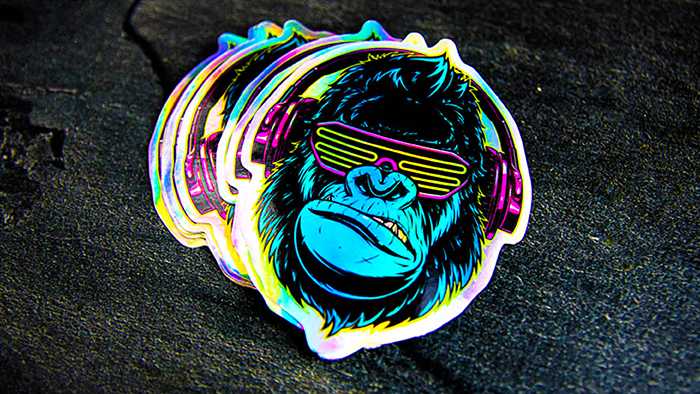When you order your custom die cut stickers, you will receive a digital proof showing your print-ready artwork with an added cut line. But what about the thickness of your sticker?
In this article, we are diving into just that and will talk you through the different die cut sticker material options you have and why their thickness matters.
Since die cuts can be printed on a whole host of materials, the thickness of your custom stickers ranges from around 245 microns to 280 microns. That is about 0.245 to 0.28 mm.
Die cut sticker printing uses microns and GSM (grams per square meter) as units, simply because stickers are comparatively small.

Different die cut sticker materials and their thickness
Die cuts are custom shaped stickers. The term only entails that your sticker will be cut through the media layer, the adhesive and the paper backing material.
It does not contain any information about the material your stickers are printed on. If you are looking for more details on your options, check out the data sheets attached to each of them on our materials page.
The material you are choosing when ordering die cut stickers can influence the thickness of the fin for three reasons:
Media
Of course, the thickness of your stickers depends on the material you choose. Our vinyl materials are between 70 and 90 microns thick.
The eco-friendly sticker range is a little thinner at 46 microns, whereas the biodegradable paper is among our thickest materials at 125 microns.
While the differences sound rather drastic, remember to break the microns down to millimeters. Then there is very minimal difference between the options.

Lamination
Lamination is an optional step in the sticker making process. When you order die cut vinyl stickers, they will generally be laminated. The laminated layer is about 70 microns thick.
We use a gloss laminate to make your stickers weather resistant, resistant to scratches and waterproof - perfect for indoor and outdoor use.
When you order sustainable stickers, they will not be laminated as it would interfere with the biodegradable nature of these stickers.
White ink
Materials like clear, mirror silver, mirror gold, holographic, glitter and fluorescent often have white ink printed onto them.
When we print white ink on an effect material, we dilute the effect and make the colors that will be printed on top of the white ink appear "normal".
As we are essentially using two layers of ink, your stickers will be around 15 microns thicker. This can lead to slight differences despite having chosen the same material.

Why is the thickness of custom die cut stickers important?
When it comes to stickers, we associate thickness with quality. The thicker the stickers, the more premium they feel - and the easier they are to peel.
This is essential when you are using stickers for your branding as they will become associated with your business; whether you are labelling your products, selling single stickers, giving them to customers to promote your brand or distributing your logo.
If you are looking for more tips on using custom stickers to promote your brand, read our blog post "The top 3 ways to use die cut stickers for your business"
And that is all you need to know about the thickness of your custom die cut stickers. If you want to create a custom sticker design, make sure to try out Graphic, our free online design tool and browse hundreds of templates.
Looking for more information on die cut stickers? Then these articles are perfect for you:
- What is a die cut sticker?
- What is the difference between a kiss cut and a die cut sticker?
- How to make your own die cut stickers
- How to apply die cut stickers

Comments
0 comments
Please sign in to leave a comment.